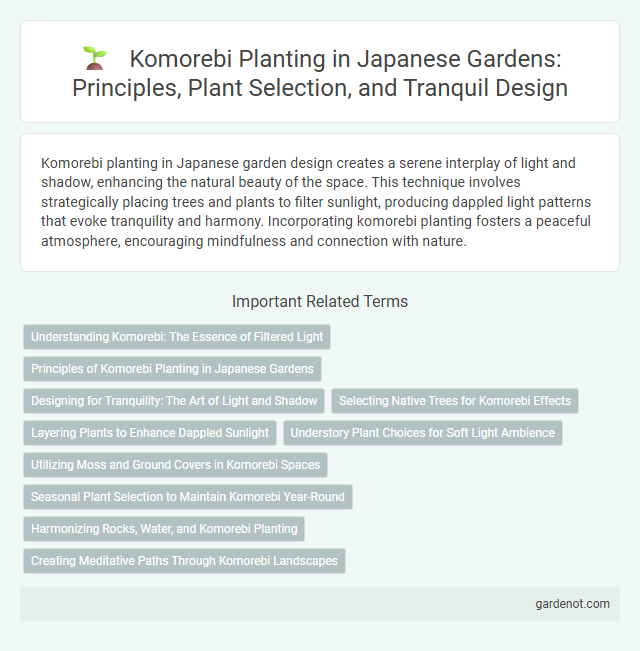Komorebi planting in Japanese garden design creates a serene interplay of light and shadow, enhancing the natural beauty of the space. This technique involves strategically placing trees and plants to filter sunlight, producing dappled light patterns that evoke tranquility and harmony. Incorporating komorebi planting fosters a peaceful atmosphere, encouraging mindfulness and connection with nature.
Understanding Komorebi: The Essence of Filtered Light
Komorebi planting captures the unique interplay of sunlight filtering through tree leaves, creating a dynamic pattern of light and shadow essential to Japanese garden aesthetics. This technique emphasizes the placement of shade-tolerant plants beneath deciduous trees to mimic natural dappled light, enhancing the garden's tranquil atmosphere. Understanding Komorebi involves recognizing how filtered light influences plant growth, texture, and visual harmony within traditional garden design.
Principles of Komorebi Planting in Japanese Gardens
Komorebi planting in Japanese gardens emphasizes the interplay of light and shadow created by strategically placed trees and shrubs, fostering a serene atmosphere. This technique prioritizes seasonal variation, using species like maple and bamboo to showcase changing foliage and dappled sunlight throughout the year. Careful layering and spacing enhance depth and natural flow, maintaining harmony with surrounding elements such as stones, water features, and pathways.
Designing for Tranquility: The Art of Light and Shadow
Komorebi planting in Japanese gardens strategically arranges trees and foliage to create dappled sunlight, enhancing tranquility through natural light and shadow interplay. The artful placement of maples, pines, and bamboo allows sunlight to gently filter, fostering a serene atmosphere conducive to meditation and reflection. This design technique emphasizes harmonious balance, connecting visitors with nature's subtle rhythms.
Selecting Native Trees for Komorebi Effects
Selecting native trees, such as Japanese maple (Acer palmatum) and hinoki cypress (Chamaecyparis obtusa), enhances the komorebi effect by creating dappled sunlight patterns unique to Japanese gardens. These species have foliage densities and branching structures that allow sunlight to filter gently through, producing the characteristic interplay of light and shadow. Incorporating native trees adapted to local climate conditions ensures sustainability while maintaining authentic komorebi aesthetics.
Layering Plants to Enhance Dappled Sunlight
Komorebi planting in Japanese gardens strategically layers shade-tolerant plants such as hostas, ferns, and mosses beneath taller trees like maples and ginkgos to filter dappled sunlight effectively. This multi-tiered vegetation arrangement enhances the interplay of light and shadow, creating a dynamic, serene atmosphere that emphasizes natural beauty. The careful selection of plant textures and heights maximizes photosynthesis while maintaining the delicate balance characteristic of traditional Japanese garden aesthetics.
Understory Plant Choices for Soft Light Ambience
Komorebi planting in Japanese gardens emphasizes understory plants like ferns, hostas, and mosses that thrive in dappled shade, creating a soft, diffused light ambiance. Shade-tolerant species such as Japanese painted ferns (Athyrium niponicum) and dwarf azaleas enhance texture and depth while complementing the filtered sunlight. Thoughtful selection of these plants supports the garden's serene atmosphere by balancing light and shadow beneath taller trees.
Utilizing Moss and Ground Covers in Komorebi Spaces
Komorebi planting in Japanese gardens emphasizes the delicate interplay of dappled sunlight and lush greenery, making moss and ground covers essential for enhancing this effect. Moss species such as Hypnum, Dicranum, and Bryum create a soft, verdant carpet that thrives in shaded areas under tree canopies, contributing to the garden's tranquil, natural ambiance. Ground covers like Ajuga and Pachysandra complement moss by providing texture and seasonal color variations, ensuring year-round visual interest in Komorebi spaces.
Seasonal Plant Selection to Maintain Komorebi Year-Round
Seasonal plant selection is crucial for maintaining komorebi--the dappled sunlight effect--in a Japanese garden throughout the year. Evergreen trees like pine and camellia provide consistent shade, while deciduous maples and cherry blossoms create dynamic light patterns with seasonal foliage changes. Incorporating layered understory plants such as azaleas and ferns ensures depth and continuity of filtered light across all seasons.
Harmonizing Rocks, Water, and Komorebi Planting
Komorebi planting in Japanese gardens skillfully harmonizes rocks, water, and vegetation to create a serene, natural atmosphere. The interplay of dappled sunlight filtering through leaves enhances the textured surfaces of stones and the reflective qualities of water features. This design technique emphasizes balance and tranquility, connecting natural elements to evoke peaceful contemplation.
Creating Meditative Paths Through Komorebi Landscapes
Komorebi planting in Japanese gardens emphasizes the interplay of light and shadow, creating meditative paths that invite quiet reflection and mindfulness. By strategically placing trees and shrubs to filter sunlight, these landscapes evoke a calming ambiance, enhancing the sensory experience for visitors. The gentle dappled light fosters a serene atmosphere, transforming garden walks into moments of peaceful contemplation.
Komorebi planting Infographic

 gardenot.com
gardenot.com